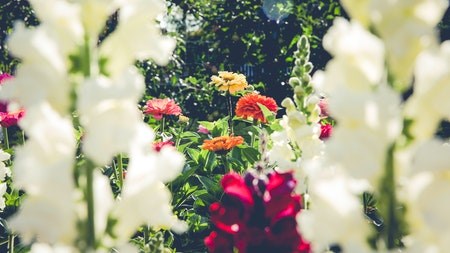March is a wonderful month in the garden, and as the days grow shorter, gardeners inevitably start thinking of their winter and spring gardens.
Gardening in the cooler weather is a pleasure. If you take care of tidying, planting and sowing now, your seedlings will have a chance to establish themselves before the cold weather sets in, ensuring a beautiful winter show.
All you need to do then is to water and maintain the garden, allowing ample time to snuggle up indoors and enjoy winter.
Gardening in South Africa suggests the following tasks for your garden this month.
Summer rainfall regions
In cold regions, start cutting back on the amount of water for established shrubs and trees, watering thoroughly but less often. Overwatering - and overfeeding – now will cause your plants to produce lots of soft new growth, which the first severe frost will kill off. Harden the wood of plants slowly now to withstand the coming dry season and low temperatures.
- In early March, feed the entire garden, including lawns, citrus trees and roses for the last time this season with an organic 3:1:5 fertiliser and water it in well. Never throw fertiliser up against the stems of plants, and never apply too much.
- Delay pruning because lush summer growth will protect plants from frost.
- Be sure not to mow lawns too short, or they won’t recover properly before winter.
- Plant hardy shrubs and trees so that they will be settled by spring when the first rains arrive.
Winter rainfall regions
The end of summer can be a dry time, so it’s important to continue with responsible water-wise gardening practices.
- Plant shrubs and trees so that they will be well established by summer. It is also the perfect time to plant fynbos species like proteas, ericas, leucospermums and Leucadendrons; and introduce some buchu.
- Plant indigenous bulbs like Babiana, Freesia, Sparaxis, Tritonia, Ixias, Gladioli, Chincherinchee and Lachenalias.
- Re-pot outdoor container plants so that they can settle down and make roots while the weather is still warm but not too hot, and benefit from the first autumn showers.
- As the weather cools, start some light pruning and tidying up, removing spent flowers and any ugly branches on trees and shrubs. Prune summer flowering shrubs once they have finished blooming, as well as summer-flowering perennials like daisy bushes, salvia and lavender.
- Prune down and feed dianthus and begonias to promote another flush of flowers in autumn.
- Mulch garden beds to help prevent soil erosion when the rains come.
Subtropical regions
This is the best season to garden in these regions, so enjoy the cooler weather and prepare for a glorious winter and spring flower, vegetable and herb garden.
- Many summer flowering plants and vegetables grow better during the winter season in these regions, so prepare beds for planting now.
- Feed your lawn every six weeks with a balanced organic fertiliser high in nitrogen, and allow it to grow longer than usual.
- Feed the rest of the garden with organic 3:1:5 and water it in well.
- Mulch garden beds to help retain moisture and keep the soil cool.
- Prune all summer flowering shrubs that have finished flowering, including Tibouchinas, which respond well to heavy pruning every four or five years. If Strelitzias are overcrowded, divide them now.
- Start sowing pansy, viola, Iceland poppy, lorenia, zinnia, begonia, alyssum, snapdragons, bellis perennis, lupin and lavatera.
- Wait till the end of March or early April to sow Namaqualand daisies, Bokbaai vygies, calendula, cornflowers, Virginian stocks, and nemesia. These annuals grow easily when sown directly into well-prepared garden beds.
Dry, semi-arid regions
Start reducing the amount of water you give established shrubs and trees; consider watering thoroughly but less often.
- Don’t prune too much now because the summer growth will protect plants from frost, and don’t mow your lawn too short.
- Plant hardy shrubs and trees to settle nicely by spring when the first rains arrive.
- In early March, give the whole garden - including the lawn, citrus trees and roses - a last feed for this season with an organic 3:1:5 fertiliser and water it in well.
- Tidy perennials and mulch them well to prevent the soil from freezing.
- You can divide Irises now, re-planting only strong, healthy pieces and mulching well. Mark the places where they are growing, so you don’t accidentally dig them up in winter.
- Buy winter seeds now and start sowing as soon as the weather cools.
- Wait until the end of March or early April to sow Namaqualand daisies, Bokbaai vygies, calendula, cornflowers and Virginian stocks when soil temperatures have cooled significantly.
Because regions can vary significantly in climate within quite small distances, always check with your local garden centre for the exact times for sowing and planting.
Writer : Sarah-Jane Meyer





